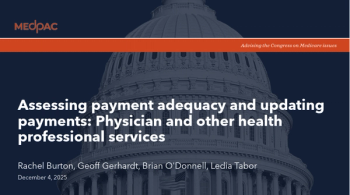
- January 10, 2019 edition
- Volume 96
- Issue 1
Asking about opioid use now part of Medicare welcome and annual visits
Physicians should update templates to include info on patients who are at risk or are using opioids.
Opioid use has become a top priority, and, as part of that, CMS emphasizes that review of a patient’s opioid use should be a standard element of the Initial Preventative Physical Exam (IPPE) also known as “welcome to Medicare”, and the initial and subsequent Annual Wellness Visit (AWV).
Medicare has included the following languarge as part of the review of the patient’s medical history for IPPE visits and AWVs: “Medicare would like to emphasize that review of opioid use is a routine component of this element, including Opioid Use Disorder (OUD). If a patient is using opioids, assess the benefit from other, non-opioid pain therapies instead, even if the patient does not have OUD but is possibly at risk.”
IPPE visits
The IPPE is covered for all Medicare beneficiaries once during their first year of becoming a beneficiary of Part B coverage, and the elements of the IPPE include:
- Review the patient’s medical and social history
- Review potential risk factors for depression and other mood disorders
- Review functional ability and level of safety
- Measurement of height, weight, body mass index (BMI), and visual acuity screening
- End-of-life planning (upon agreement of the individual)
- Education, counseling and referral based on the review of previous 5 components
- Education, counseling and referral for other preventive services, including a brief written plan such as a checklist
Annual wellness visits
Medicare covers AWVs for patients who are no longer within their first year of their Part B coverage, and who haven’t had an AWV or IPPE within the last 12 months. The initial AWV is a once in a lifetime benefit, which means that Medicare only pays for this visit once per patient. The subsequent AWV is covered once every 12 months. The elements for the initial AWV are:
- A health risk assessment
- Establishment of a current list of provider and suppliers
- Review of medical and family history Measurement of height, weight, BMI, and blood pressure
- Review of potential risk factors for depression and other mood disorders
- Review of functional ability and level of safety Detection of any cognitive impairment the patient may have
- Establishment of a written screening schedule (such as a checklist)
- Establishment of a list of risk factors
- Provision of personalized health advice and referral to appropriate health education or other preventive services
Subsequent AWVs include the following elements:
- Review of updated health risk assessment
- Update medical and family history
- Update of list of current providers and suppliers
- Measurement of weight and blood pressure
- Detection of cognitive impairment the patient may have
- Update of the written screening schedule (such as a checklist)
- Update of the list of risk factors
- Provision of personalized health advice and referral to appropriate health education or other preventive services
Physicians should update templates to include info on patients who are at risk or are using opioids.
Renee Dowling is a billing and coding consultant with VEI Consulting in Indianapolis, Indiana. Send your coding questions to [email protected].
Articles in this issue
almost 7 years ago
The benefit of flexible patient payment optionsalmost 7 years ago
EHR market consolidation and the impact on physiciansalmost 7 years ago
Your voice: Lowering the cost of a medical educationalmost 7 years ago
Getting paid in 2019almost 7 years ago
Eliminate claim denials for medical necessityalmost 7 years ago
Treating obesity: How to individualize careabout 7 years ago
What primary care physicians can do about rising rates of obesityover 7 years ago
Physician moonlighting doesn’t mean major travel burdensNewsletter
Stay informed and empowered with Medical Economics enewsletter, delivering expert insights, financial strategies, practice management tips and technology trends — tailored for today’s physicians.














